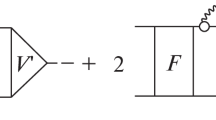Abstract
The Green function formalism with a consistent account for phonon coupling (PC), based on the self-consistent theory of finite Fermi systems, is applied for pygmy- and giant multipole resonances in magic nuclei with the aim to consider particle–hole (ph) and complex 1p1h\(\otimes \)phonon configurations. A new equation for the effective field, which describes nuclear polarizability, is obtained. It contains new PC contributions, which are of interest in the energy region under consideration. They are due to: (1) the tadpole effect in the standard ph-propagator, (2) two new induced interactions (caused by the exchange of the ph-phonon) in the second ph-channel and in the particle–particle channels, and (3) the first and second variations of the effective interaction in the phonon field. The general expressions for energies and probabilities of transitions between the ground and excited states are obtained. The qualitative analysis and discussion of the new terms are performed.







Similar content being viewed by others
Data Availability Statement
This manuscript has no associated data or the data will not be deposited. [Authors’ comment: This is a theoretical study and no experimental data has been listed.]
Notes
For a more exact derivation of the equation for the effective field with PC, it is necessary to refrain from the restriction to the complex 1p1h\(\otimes \)phonon configurations only. In this case, the general structure of the new equation will be similar to Eq. (16) and, what is important, all the new above-mentioned ingredients of our approach will remain the same.
References
N. Paar, D. Vretenar, E. Khan, G. Colo, Rep. Prog. Phys. 70, 691 (2007)
A. Bracco, E.G. Lanza, A. Tamii, Prog. Part. Nucl. Phys. 106, 360 (2019)
S.P. Kamerdzhiev, O.I. Achakovskiy, S.V. Tolokonnikov, M.I. Shitov, Phys. At. Nucl. 82, 366 (2019)
S. Kamerdzhiev, J. Speth, G. Tertychny, Phys. Rep. 393, 1 (2004)
A. Avdeenkov, S. Goriely, S. Kamerdzhiev, S. Krewald, Phys. Rev. C 83, 064316 (2011)
S. Goriely, E. Khan, V. Samyn, Nucl. Phys. A 739, 331 (2004)
S.P. Kamerdzhiev, A.V. Avdeenkov, D.A. Voitenkov, Phys. At. Nucl. 74, 1478 (2011)
V. Tselyaev, N. Lyutorovich, J. Speth, S. Krewald, P.-G. Reinhard, Phys. Rev. C 94, 034306 (2016)
N.A. Lyutorovich, V.I. Tselyaev, O.I. Achakovskiy, S.P. Kamerdzhiev, JETP Lett. 107, 659 (2018)
A. Repko, V.O. Nesterenko, J. Kvasil, P.-G. Reinhard, Eur. Phys. J. A 55, 242 (2019)
A. Tamii, I. Poltoratska, P. von Neumann-Cosel, Y. Fujita, T. Adachi, C.A. Bertulani, J. Carter, M. Dozono, H. Fujita, K. Fujita, K. Hatanaka, D. Ishikawa, M. Itoh, T. Kawabata, Y. Kalmykov, A.M. Krumbholz, E. Litvinova, H. Matsubara, K. Nakanishi, R. Neveling, H. Okamura, H.J. Ong, B. Özel-Tashenov, V.Y. Ponomarev, A. Richter, B. Rubio, H. Sakaguchi, Y. Sakemi, Y. Sasamoto, Y. Shimbara, Y. Shimizu, F.D. Smit, T. Suzuki, Y. Tameshige, J. Wambach, R. Yamada, M. Yosoi, J. Zenihiro, Phys. Rev. Lett. 107, 062502 (2011)
A.C. Larsen, J.E. Midtbø, M. Guttormsen, T. Renstrøm, S.N. Liddick, A. Spyrou, S. Karampagia, B.A. Brown, O. Achakovskiy, S. Kamerdzhiev, D.L. Bleuel, A. Couture, L. Crespo Campo, B.P. Crider, A.C. Dombos, R. Lewis, S. Mosby, F. Naqvi, G. Perdikakis, C.J. Prokop, S.J. Quinn, S. Siem, Phys. Rev. C 97, 054329 (2018)
E.E. Saperstein, S.V. Tolokonnikov, Yad. Fiz. 79, 703 (2016) [Phys. At. Nucl. 79, 1030 (2016)]
V.A. Khodel, E.E. Saperstein, Phys. Rep. 92, 183 (1982)
A.V. Smirnov, S.V. Tolokonnikov, S.A. Fayans, Sov. J. Nucl. Phys. 48, 995 (1988)
D. Voitenkov, S. Kamerdzhiev, S. Krewald, E.E. Saperstein, S.V. Tolokonnikov, Phys. Rev. C 85, 054319 (2012)
A.B. Migdal, Theory of Finite Fermi Systems and Applications to Atomic Nuclei (Nauka, Moscow, 1965)
A.B. Migdal, Theory of Finite Fermi Systems and Applications to Atomic Nuclei (Interscience, New York, 1967)
S.P. Kamerdzhiev, Yad. Fiz. 38, 316 (1983)
S.P. Kamerdzhiev, Sov. J. Nucl. Phys. 38, 188 (1989)
V.I. Tselyaev, Yad. Fiz. 50, 1252 (1989) [Sov. J. Nucl. Phys. 50, 780 (1989)]
V. Tselyaev, Phys. Rev. C 75, 024306 (2007)
S.P. Kamerdzhiev, V.N. Tkachev, Z. Phys. A 334, 19 (1989)
E. Litvinova, P. Schuck, Phys. Rev. C 102, 034310 (2020)
V. Tselayev, N. Lyutorovich, J. Speth, P.-G. Reinhard, Phys. Rev. C 97, 044308 (2018)
E. Litvinova, P. Schuck, Phys. Rev. C 100, 064320 (2019)
V.G. Soloviev, Theory of Atomic Nuclei: Quasi-Particles and Phonons (Institute of Physics, Bristol, 1992)
N. Van Giai, C. Stoyanov, V.V. Voronov, Phys. Rev. C 57, 1204 (1998)
V.A. Khodel, A.P. Platonov, E.E. Saperstein, J. Phys. G Nucl. Phys. 6, 1199 (1980)
E.E. Saperstein, O.I. Achakovskiy, S.P. Kamerdzhiev, S. Krewald, J. Speth, S.V. Tolokonnikov, Phys. At. Nucl. 77, 1033 (2014)
E.E. Saperstein, S.P. Kamerdzhiev, D.S. Krepish, S.V. Tolokonnikov, D. Voitenkov, J. Phys. G Nucl. Part. Phys. 44, 065104 (2017)
S.P. Kamerdzhiev, D.A. Voitenkov, E.E. Saperstain, S.V. Tolokonnikov, M.I. Shitov, JETP Lett. 106(3), 139 (2017)
Acknowledgements
We are grateful to V. A. Khodel, S. V. Tolokonnikov and V. I. Tselayev for useful discussions and to A. L. Barabanov, S. S. Pankratov and M. V. Zverev for discussions of selected problems. The reported study was funded by RFBR, project no. 19-31-90186 and supported by the Russian Science Foundation, project no. 16-12-10155.
Author information
Authors and Affiliations
Corresponding author
Additional information
Communicated by Michael Bender
Rights and permissions
About this article
Cite this article
Kamerdzhiev, S.P., Shitov, M.I. Microscopic theory of pygmy- and giant resonances: accounting for complex 1p1h\(\otimes \)phonon configurations. Eur. Phys. J. A 56, 265 (2020). https://doi.org/10.1140/epja/s10050-020-00224-7
Received:
Accepted:
Published:
DOI: https://doi.org/10.1140/epja/s10050-020-00224-7



